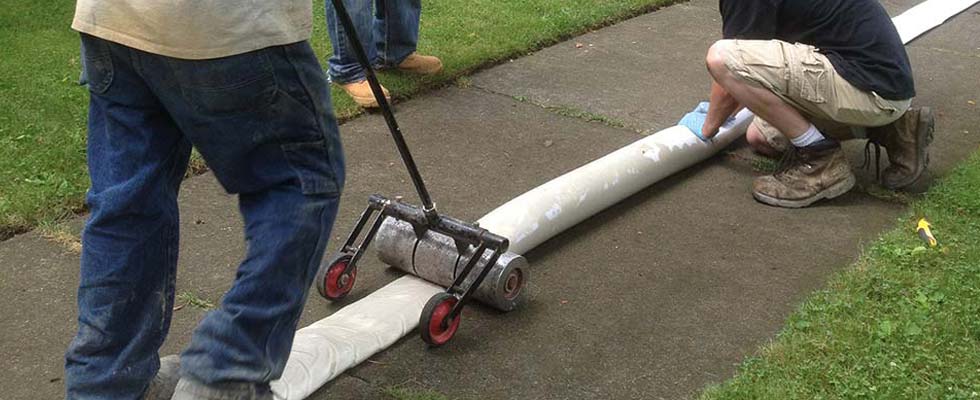- Blue Works Company FL State Lic. CFC1428593 CGC1520187
Sewer pipe lining uses the most advanced plumbing technology to fix your drain problems. You’ve probably heard it referred to by several names, including:

The innovative process uses a long special fabric tube that is saturated with resin. This hardens in about 2 to 4 hours. It is inserted into the old, damaged sewer pipe. As it hardens, a new pipe-within-a-pipe is created.
This new pipe reduces the interior diameter about 5%, not enough to noticeable affect flow or capacity, according to experts. The new pipe meets or exceeds the highest industry standards. It is engineered for a 100-year lifespan. You get a 50-year warranty.
The first step to pipe lining is to clean out the interior of the original sewer pipe with high-pressure hydro jetting. This gets ride of sludge and build-up and obliterates tree roots. A video camera inspection is done to pinpoint the exact problem and its location.
At this point the old pipe is ready for the pipe relining. A long tube made from a special fabric is cut to the length needed to handle the area of the damaged pipe that requires relining.
The resin is prepared by mixing the part A and part B epoxy resins, which are self-hardening. The fabric tube is totally saturated with this mix.
The tube is then pulled through the old pipe or blown into it using air pressure. Then the tube is inflated with air for 2 to 4 hours. This allows the resin time to harden, or cure.
Another video camera pipe inspection is done to make sure the process was accomplished correctly. At this point, you have a fully functioning new pipe.
The new pipe is effective for load-bearing pipes that are positioned under roadways, building footers and railways. If a section of a clay or cast iron sewer pipe is damaged, the new inner lining pipe will act as a standalone pipe. It is as strong and durable as the original pipe.
Pipe Lining Is NOT the Epoxy Spray-On Method
Don’t confuse this method with epoxy spray-on systems. In the case of drinking water pipes, a food-grade epoxy is sprayed inside a pipe to act as a liner. But it won’t work for load-bearing pipes.
This method is inappropriate for most major plumbing problems because it is prone to damage. For example, if the ground shifts or settles, the epoxy lining will crack and the water under pressure within the pipe will leak.
The exception is the case when thicker layers of epoxy, up to 4 mm, are applied. This is used on fire-suppression hydrant water supply pipes and water mains. In these instances, the heavier coating can add structural strength.
With pipe lining, it is possible to do a sectional repair. You can reline just the part that is damaged. For example, with clay pipes you can have the cracked area or the part with the root intrusion relined.
With cast iron pipes in apartments and homes, it makes sense to reline it all. That’s because all the pipes are the same age and have experienced the same wear and tear. When one part starts to leak or develop problems, you can safely assume the rest will follow in a short time. So it is cost-effective to do the entire pipe.
This is an effective method for a wide range of common pipe problems. Here is a look at two of them.
Constant clogs and backups. Around your home, do you constantly have drains clogging? Do you call the plumber, then need to call him again in a month or two?
Do you go through the mess of a sewage backup, then call the drain rooter. The problem is fixed for a short time, but then you need to call him again. And again?
You are probably dealing with tree roots in your pipe. Roots need water and sewage pipe provide a constant source. Roots grow in at the joints, causing cracks and leaks in the process.
The roots keep getting bigger and bigger, until the pipe is clogged. Rooters can break through the roots, but they simply grow back.
The best approach is to use hydro jetting to get rid of the tree root, Then add new pipe lining to fix the damaged old pipe.
Cracked and leaking high-rise pipes. Do your have vertical cast iron sewer pipes and rain drains in your high-rise? After 30 years or so, they often develop vertical cracks.
You can use conventional methods that involve cutting through walls to replace the pipes. But it is messy, noisy, inconvenient and time-consuming.
The better approach is installing an inner pipe lining, which is durable and strong.
Costs vary, but as a rule trenchless pipe rehabilitation is less than the cost of using the conventional sewer re-pipe method. Relining 4” cast iron pipe will run about $125 per foot outdoors and $140 inside. That is a general, ballpark figure. A technician will need to check the work and give you an estimate.
The warranty is 50 years for materials and labor.